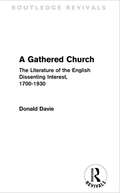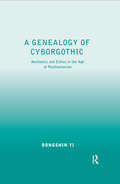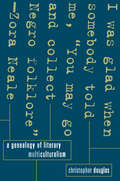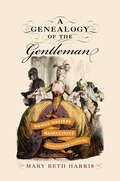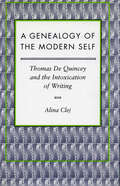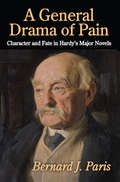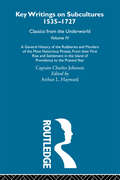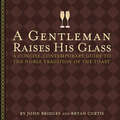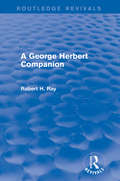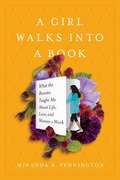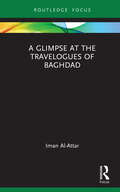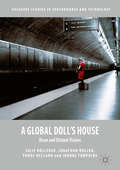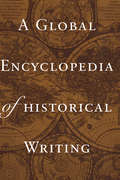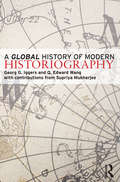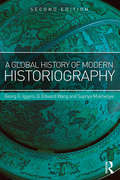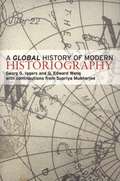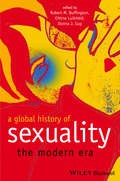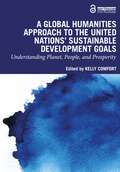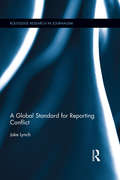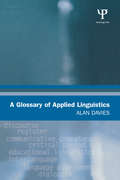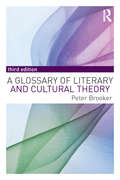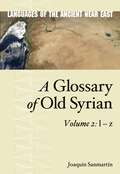- Table View
- List View
A Gathered Church: The Literature of the English Dissenting Interest, 1700-1930 (Routledge Revivals)
by Donald DavieFirst published in 1978, this study considers the impact of dissenting voices upon literature, religion and politics in order to reassess the nonconformist contribution to English culture from the eighteenth century through to the twentieth. This historical survey takes into the account the contribution of a wealth of seminal literary figures such as the poets Isaac Watts, Charles Wesley and William Blake; and the novelists Elizabeth Gaskell, George Elliot, Mark Rutherford and D. H. Lawrence. However, far from consigning his study merely to literature, Davie also includes important orators like Robert Hall; scientists like Michael Farraday and Philip Gosse; political activists like Joseph Priestly, and soldiers like Orde Wingate. Unitarians, Sandemanians, Wesleyan Methodists and the Plymouth Brethren are considered, as well as the older denominations.
A Genealogy of Cyborgothic: Aesthetics and Ethics in the Age of Posthumanism
by Dongshin YiIn his provocative and timely study of posthumanism, Dongshin Yi adopts an imaginary/imaginative approach to exploring the transformative power of the cyborg, a strategy that introduces balance to the current discourses dominated by the practicalities of technoscience and the dictates of anthropocentrism. Proposing the term "cyborgothic" to characterize a new genre that may emerge from gothic literature and science fiction, Yi introduces mothering as an aesthetic and ethical practice that can enable a posthumanist relationship between human and non-human beings. Yi examines the cyborg's literary manifestations in novels, including The Mysteries of Udolpho, Frankenstein, Dracula, Arrowsmith, and He, She and It, alongside philosophical and critical texts such as Edmund Burke's A Philosophical Enquiry into the Origins of Our ideas of the Sublime and Beautiful, Immanuel Kant's Critique of Judgment, John Stuart Mill's Utilitarianism and System of Logic, William James's essays on pragmatism, ethical treaties on otherness and things, feminist writings on motherhood, and recent studies of posthumanism. Arguing humans imagine the cyborg in ways that are seriously limited by fear of the unknown and current understandings of science and technology, Yi identifies in gothic literature a practice of the beautiful that extends the operation of sensibility, heightened by gothic manifestations or situations, to surrounding objects and people so that new feelings flow in and attenuate fear. In science fiction, which demonstrates how society has accommodated science, Yi locates ethical corrections to the anthropocentric trajectory that such accommodation has taken. Thus, A Genealogy of Cyborgothic imagines a new literary genre that helps envision a cyborg-friendly, non-anthropocentric posthuman society. Encoded with gothic literature's aesthetic embrace of fear and science fiction's ethical criticism of anthropocentrism, the cyborgothic retains the prospective nature of these genres and develops mothering as an aesthetico-ethical practice that both humans and cyborgs should perform.
A Genealogy of Literary Multiculturalism
by Christopher DouglasAs an anthropology student studying with Franz Boas, Zora Neale Hurston recorded African American folklore in rural central Florida, studied hoodoo in New Orleans and voodoo in Haiti, talked with the last ex-slave to survive the Middle Passage, and collected music from Jamaica. Her ethnographic work would serve as the basis for her novels and other writings in which she shaped a vision of African American Southern rural folk culture articulated through an antiracist concept of culture championed by Boas: culture as plural, relative, and long-lived. Meanwhile, a very different antiracist model of culture learned from Robert Park's sociology allowed Richard Wright to imagine African American culture in terms of severed traditions, marginal consciousness, and generation gaps. In A Genealogy of Literary Multiculturalism, Christopher Douglas uncovers the largely unacknowledged role played by ideas from sociology and anthropology in nourishing the politics and forms of minority writers from diverse backgrounds. Douglas divides the history of multicultural writing in the United States into three periods. The first, which spans the 1920s and 1930s, features minority writers such as Hurston and D'Arcy McNickle, who were indebted to the work of Boas and his attempts to detach culture from race. The second period, from 1940 to the mid-1960s, was a time of assimilation and integration, as seen in the work of authors such as Richard Wright, Jade Snow Wong, John Okada, and Ralph Ellison, who were influenced by currents in sociological thought. The third period focuses on the writers we associate with contemporary literary multiculturalism, including Toni Morrison, N. Scott Momaday, Frank Chin, Ishmael Reed, and Gloria Anzaldúa. Douglas shows that these more recent writers advocated a literary nationalism that was based on a modified Boasian anthropology and that laid the pluralist grounds for our current conception of literary multiculturalism.Ultimately, Douglas's "unified field theory" of multicultural literature brings together divergent African American, Asian American, Mexican American, and Native American literary traditions into one story: of how we moved from thinking about groups as races to thinking about groups as cultures—and then back again.
A Genealogy of the Gentleman: Women Writers and Masculinity in the Eighteenth Century (EARLY MODERN FEMINISMS)
by Mary Beth HarrisA Genealogy of the Gentleman argues that eighteenth-century women writers made key interventions in modern ideals of masculinity and authorship through their narrative constructions of the gentleman. It challenges two latent critical assumptions: first, that the gentleman’s masculinity is normative, private, and therefore oppositional to concepts of performance; and second, that women writers, from their disadvantaged position within a patriarchal society, had no real means of influencing dominant structures of masculinity. By placing writers such as Mary Davys, Eliza Haywood, Charlotte Lennox, Elizabeth Inchbald, and Mary Robinson in dialogue with canonical representatives of the gentleman author—Joseph Addison and Richard Steele, David Hume, Samuel Johnson, and Samuel Richardson—Mary Beth Harris shows how these women carved out a space for their literary authority not by overtly opposing their male critics and society’s patriarchal structure, but by rewriting the persona of the gentleman as a figure whose very desirability and appeal were dependent on women’s influence. Ultimately, this project considers the import of these women writers’ legacy, both progressive and conservative, on hegemonic standards of masculinity that persist to this day.
A Genealogy of the Modern Self: Thomas De Quincey and the Intoxication of Writing
by Alina ClejAs this book's title suggests, its main argument is that Thomas De Quincey's literary output, which is both a symptom and an effect of his addictions to opium and writing, plays an important and mostly unacknowledged role in the development of modern and modernist forms of subjectivity. At the same time, the book shows that intoxication, whether in the strict medical sense or in its less technical meaning ("strong excitement," "trance," "ecstasy"), is central to the ways in which modernity, and literary modernity in particular, functions and defines itself. In both its theoretical and practical implications, intoxication symbolizes and often comes to constitute the condition of the alienated artist in the age of the market. The book also offers new readings of the Confessions and some of De Quincey's posthumous writings, as well as an extended analysis of his relatively neglected diary. The discussion of De Quincey's work also elicits new insights into his relationship with William and Dorothy Wordsworth, as well as his imaginary investment in Coleridge.
A General Drama of Pain: Character and Fate in Hardy's Major Novels
by Bernard J. ParisThis motivational analysis of the protagonists in Thomas Hardy's three most widely read novels--Tess of the d'Urbervilles, The Mayor of Casterbridge, and Jude the Obscure--highlights an often-overlooked aspect of his art. Bernard J. Paris shows Hardy's genius in creating imagined human beings. He demonstrates that while Hardy tends to blame external conditions for his characters' painful fates, their downfalls are due to a very complex combination of cosmic, social, and psychological factors. Hardy's characters are usually discussed primarily in thematic terms. The characters are are so richly portrayed, Paris argues, that they can be better understood independent of Hardy's interpretations, in motivational terms and he utilizes the psychologist Karen Horney's theories to recover Hardy's intuitions. The characters are full of inner conflicts that make them difficult to fathom, but the approach Paris employs explains their contradictions and illuminates their troubled relationships--shedding light on these expertly crafted imagined human beings. This psychological approach to Hardy's characters enables us to understand his characters and gain insight into the implied authors of the works. In addition, the approach shows Hardy's authorial personality. We can see that Hardy treats some defensive strategies more sympathetically than others. Given his view of life as a general drama of pain, resignation, like that of Hardy's character Elizabeth-Jane, is the strategy he prefers.
A General History of the Robberies and Murders of the Most Notorious Pirates - from their first rise and settlement in the Island of Providence to the present year: Previously published 1726 and 1927 (Key Writings On Subcultures, 1535-1727 Ser. #Vol. 3)
by Captain Charles JohnsonA General History of the Pirates has long been a classic of seafaring literature and was inspiration to both Robert Louis Stevenson and J.M. Barrie. Nothing is known about Captain Charles Johnson, and it is thought that the name may be assumed - there are even some who believe he may have been Daniel Defoe. All that can be stated with any certainty is that in 1724 a small octavo volume appeared that became so popular it grew through 4 editions over 2 years and is still famed today. Historians from both sides of the Atlantic have attested to the accuracy of the work's content. This is a reprint of the 1927 reissued 4th edition - enhanced by the Arthur L. Hayward's editorial touches.
A Gentleman Raises His Glass: A Concise, Contemporary Guide to the Noble Tradition of the Toast
by Bryan Curtis John BridgesA concise guide to giving meaningful, appropriate toasts for virtually any occasion, from the author of How to Be a Gentleman.A Gentleman Raises His Glass teaches how to prepare a toast for virtually any occasion—be it a wedding, a celebratory dinner, or any social celebration where a tribute would be welcome. It also tells the history of the toast, gives examples of the right and wrong things to say, and contains more than fifty aphorisms on toasting:A gentleman knows that, unless he is seated in a crowded public restaurant, he must stand to deliver a toastWhen a gentleman makes a toast, he makes it directly to his guest of honor, not to the table at largeA gentleman knows that a toast, even at a bachelor’s dinner, is still intended to be a tribute—not an embarrassment
A George Herbert Companion (Routledge Revivals)
by Robert H. RayFirst published in 1995, this title provides the reader with a compendium of useful information for any reader of George Herbert to have at hand. It includes key biographical information, situates the poetry in its historical and cultural context, and, where appropriate, explains theological concepts and traditions which have a direct bearing on the verse. The aim throughout is to enhance understanding and appreciation, without being exhaustive. A George Herbert Companion will be of most use to general readers and undergraduate students coming to this poetry for the first time, and will interest students of Anglican Caroline theology and hymnology.
A Girl Walks into a Book: What the Brontës Taught Me about Life, Love, and Women's Work
by Miranda PenningtonHow many times have you heard readers argue about which is better, Jane Eyre or Wuthering Heights? The works of Charlotte, Emily, and Anne continue to provoke passionate fandom over a century after their deaths. Brontë enthusiasts, as well as those of us who never made it further than those oft-cited classics, will devour Miranda Pennington's delightful literary memoir.Pennington, today a writer and teacher in New York, was a precocious reader. Her father gave her Jane Eyre at the age of 10, sparking what would become a lifelong devotion and multiple re-readings. She began to delve into the work and lives of the Brontës, finding that the sisters were at times her lifeline, her sounding board, even her closest friends. In this charming, offbeat memoir, Pennington traces the development of the Brontës as women, as sisters, and as writers, as she recounts her own struggles to fit in as a bookish, introverted, bisexual woman. In the Brontës and their characters, Pennington finally finds the heroines she needs, and she becomes obsessed with their wisdom, courage, and fearlessness. Her obsession makes for an entirely absorbing and unique read. A Girl Walks Into a Book is a candid and emotional love affair that braids criticism, biography and literature into a quest that helps us understand the place of literature in our lives; how it affects and inspires us.
A Glimpse at the Travelogues of Baghdad (Routledge Focus on Literature)
by Iman Al-AttarThe history of Baghdad in the 18th and 19th centuries had predominantly been written by two groups. The first group is Baghdadi scholars, and the second group is travellers. These two resources complement each other; while the literature of Baghdadi scholars provides insights from inside, travelogues provide observations from outside. By implementing this interlocking method of investigation, we can reach a comprehensive understanding of the history of Baghdad. Having investigated some sources from inside in my previous book; Baghdad: an urban history through the lens of literature, the focus of this book is on travel literature. The history of travelogues throughout different periods of Baghdad’s history is highlighted, with a particular focus on 18th and 19th century travelogues. This period was a critical epoch of change, not just in Baghdad, but across the world. Nevertheless, this book does not intend to provide a documentary of the travellers who visited Baghdad. It is rather an analytical study of the colonial literature in relation to the historiography of Baghdad.
A Global Doll's House: Ibsen and Distant Visions (Palgrave Studies in Performance and Technology)
by Julie Holledge Jonathan Bollen Frode Helland Joanne TompkinsThis book addresses a deceptively simple question: what accounts for the global success of A Doll's House, Henrik Ibsen's most popular play? Using maps, networks, and images to explore the world history of the play's production, this question is considered from two angles: cultural transmission and adaptation. Analysing the play's transmission reveals the social, economic, and political forces that have secured its place in the canon of world drama; a comparative study of the play's 135-year production history across five continents offers new insights into theatrical adaptation. Key areas of research include the global tours of nineteenth-century actress-managers, Norway's soft diplomacy in promoting gender equality, representations of the female performing body, and the sexual vectors of social change in theatre.
A Global Encyclopedia of Historical Writing, Volume 2
by D. R. WoolfFirst published in 1998. Including a wide range of information and recommended for academic libraries, this encyclopedia covers historiography and historians from around the world and will be a useful reference to students, researchers, scholars, librarians and the general public who are interested in the writing of history. Volume II covers entries from K to Z.
A Global History of Modern Historiography
by Q. Edward Wang Supriya Mukherjee Georg G IggersSo far histories of historiography have concentrated almost exclusively on the West. This is the first book to offer a history of modern historiography from a global perspective. Tracing the transformation of historical writings over the past two and half centuries, the book portrays the transformation of historical writings under the effect of professionalization, which served as a model not only for Western but also for much of non-Western historical studies. At the same time it critically examines the reactions in post-modern and post-colonial thought to established conceptions of scientific historiography. A main theme of the book is how historians in the non-Western world not only adopted or adapted Western ideas, but also explored different approaches rooted in their own cultures.
A Global History of Modern Historiography
by Q. Edward Wang Supriya Mukherjee Georg G IggersThe first book on historiography to adopt a global and comparative perspective on the topic, A Global History of Modern Historiography looks not just at developments in the West but also at the other great historiographical traditions in Asia, the Middle East, and elsewhere around the world over the course of the past two and a half centuries. This second edition contains fully updated sections on Latin American and African historiography, discussion of the development of global history, environmental history, and feminist and gender history in recent years, and new coverage of Russian historical practices. Beginning in the mid-eighteenth century, the authors analyse historical currents in a changing political, social and cultural context, examining both the adaptation and modification of the Western influence on historiography and how societies outside Europe and America found their own ways in the face of modernization and globalization. Supported by online resources including a selection of excerpts from key historiographical texts, this book offers an up-to-date account of the status of historical writing in the global era and is essential reading for all students of modern historiography.
A Global History of Modern Historiography
by Georg G. Iggers Q. Edward Wang Supriya MukherjeeA critical survey of historical thought and writing since the late eighteenth century from an intercultural, comparative global perspective. A comprehensive overview of historical thought and writing in the modern period. The first history of modern historiography which deals with the interaction of Western and non-Western historical thought. Sets historiography into its social, political and cultural context.
A Global History of Modern Historiography
by Q. Edward Wang Supriya Mukherjee Georg IggersThe first book on historiography to adopt a global and comparative perspective on the topic, A Global History of Modern Historiography looks not just at developments in the West but also at the other great historiographical traditions in Asia, the Middle East, and elsewhere around the world over the course of the past two and a half centuries. This second edition contains fully updated sections on Latin American and African historiography, discussion of the development of global history, environmental history, and feminist and gender history in recent years, and new coverage of Russian historical practices. Beginning in the mid-eighteenth century, the authors analyse historical currents in a changing political, social and cultural context, examining both the adaptation and modification of the Western influence on historiography and how societies outside Europe and America found their own ways in the face of modernization and globalization.Supported by online resources including a selection of excerpts from key historiographical texts, this book offers an up-to-date account of the status of historical writing in the global era and is essential reading for all students of modern historiography.
A Global History of Sexuality: The Modern Era
by Donna J. Guy Robert M. Buffington Eithne LuibhéidA Global History of Sexuality provides a provocative, wide-ranging introduction to the history of sexuality from the late eighteenth century to the present day. Explores what sexuality has meant in the everyday lives of individuals over the last 200 years Organized around four major themes: the formation of sexual identity, the regulation of sexuality by societal norms, the regulation of sexuality by institutions, and the intersection of sexuality with globalization Examines the topic from a comparative, global perspective, with well-chosen case studies to illuminate the broader themes Includes interdisciplinary contributions from prominent historians, sociologists, anthropologists, and sexuality studies scholars Introduces important theoretical concepts in a clear, accessible way
A Global Humanities Approach to the United Nations' Sustainable Development Goals: Understanding Planet, People, and Prosperity
by Kelly ComfortThis edited textbook explores the 17 UN SDGs through 12 works from the humanities, including films, novels, and photographic collections. It provides students with the knowledge and understanding of how the humanities engage in broader social, political, economic, and environmental dialogue, offering a global perspective that crosses national and continental borders. The book takes students through the UN SDGs from a theoretical perspective through to practical applications, first through specific global humanities examples and then through students’ own final projects and reflections. Centered around three major themes of planet, people, and prosperity, the textbook encourages students to explore and apply the Goals using a place-based, culturally rooted approach while simultaneously acknowledging and understanding their global importance. The text’s examples range from documentary and feature film to photography and literature, including Wang Jiuliang’s Plastic China, Kip Andersen and Keegan Kuhn’s Cowspiracy: The Sustainability Secret, Barbara Dombrowski’s Tropic Ice: Dialog Between Places Affected by Climate Change, and Aravind Adiga’s The White Tiger, among others. Providing diverse geographic and cultural perspectives, the works take readers to Argentina, Australia, China, Costa Rica, Ecuador, France, Greenland, Haiti, India, Japan, Peru, Rwanda, Senegal, and the United States. This broad textbook can be used by students and instructors at undergraduate and postgraduate levels from any subject background, particularly, but not exclusively, those in the humanities. With added discussion questions, research assignments, writing prompts, and creative project ideas, students will gain a nuanced understanding of the interconnectivity between social, cultural, ethical, political, economic, and environmental factors.
A Global Standard for Reporting Conflict (Routledge Research in Journalism)
by Jake LynchA Global Standard for Reporting Conflict constructs an argument from first principles to identify what constitutes good journalism. It explores and synthesises key concepts from political and communication theory to delineate the role of journalism in public spheres. And it shows how these concepts relate to ideas from peace research, in the form of Peace Journalism. Thinkers whose contributions are examined along the way include Michel Foucault, Johan Galtung, John Paul Lederach, Edward Herman and Noam Chomsky, Manuel Castells and Jurgen Habermas. The book argues for a critical realist approach, considering critiques of ‘correspondence’ theories of representation to propose an innovative conceptualisation of journalistic epistemology in which ‘social truths’ can be identified as the basis for the journalistic remit of factual reporting. If the world cannot be accessed as it is, then it can be assembled as agreed – so long as consensus on important meanings is kept under constant review. These propositions are tested by extensive fieldwork in four countries: Australia, the Philippines, South Africa and Mexico.
A Glossary of Applied Linguistics
by Alan DaviesApplied Linguistics is still a growing field. Key texts and handbooks have appeared in recent years and international applied linguistics conferences and professional associations occur regularly. While Applied Linguistics continues to attract new entrants and to generate new strands of research, there is a need for a clear and concise map of the field. This is the purpose of the Glossary.The author, Alan Davies, is a well-established, well-published authority on applied linguistics. Not a typically dry dictionary, Dr. Davies infuses the alphabetical entries with a touch of humor and thought-provoking context creating an up-to-date, useful, and coherent view of applied linguistics.The Glossary compiles the most ubiquitously used terms in applied linguistics and teacher-training literature. It takes a wide-ranging view of the field, drawing not only on linguistics but including psychology, sociology, education, measurement theory, speech therapy, translation, and language planning. Other features include:*numerous cross-references to key terms;*an introduction, which discusses the difficulty of defining applied linguistics; and*a brief reading list of key text.The primary market is master's student in Applied Linguistics, Second Language Acquisition, and TESL/TEFL. Undergraduate students, particularly in language fields and in education will also find it helpful, as well as language teachers who have not themselves followed Applied Linguistics courses and who are interested in finding out about the field.
A Glossary of Literary Terms
by M. H. Abrams Geoffrey Galt HarphamThis book defines and discusses terms, critical theories, and points of view that are commonly applied in classifying, analyzing, interpreting, and writing the history of works of literature. The component entries, together with the guides to further reading included in most of them, are oriented especially toward undergraduate students of English, American, and other literatures. Over the decades, however, the book has proved to be a useful and popular work of reference for advanced students, as well as for the general reader with literary interests.
A Glossary of Literary and Cultural Theory
by Peter BrookerThe Glossary of Literary and Cultural Theory provides researchers and students with an up-to-date guide through the vibrant and changing debates in Literary and Cultural Studies. In a field where meanings are frequently complex and ambiguous, this text is remarkable for its clarity and usefulness. This third edition includes 17 entirely new entries and updates to more than a dozen others which address key concepts and contemporary positions in both literary and cultural theory. New entries include: • Actor Network Theory • Anthropocene • Ecocriticism • Digital Humanities • Postcapitalism • World Literature
A Glossary of Old Syrian: Volume 1: ʔ – ḳ (Languages of the Ancient Near East)
by Joaquin SanmartínA Glossary of Old Syrian: ʔ – ḳ is the first of two volumes aimed at the completion of a lexicographical index of the Old Syrian linguistical continuum. This glossary gives a picture, or map, of the Old Syrian lexicon as it can be extracted and reconstructed from the available sources, from the (Old Akkadian-)Eblatic through the Old and Middle Babylonian corpora.Old Syrian can be defined most appropriately as a diachronically conservative, geographically pluricentric, and pragmatically multilayered linguistic cluster. Therefore, the present work pays special attention to the distribution of lexical data along diatopic and diastratic criteria. In view of the enormous amount of material and the dispersion of the data, this glossary focuses on the most representative textual corpora of the Old Syrian linguistic landscape. The bibliographical references are kept deliberately succinct and as a rule, restricted to the classic works that may be easily found in every Assyriological or Semitic library, public or private, and that will redirect the users to their sources. Since the Old Syrian lexicography remains uncertain, the leading interpretative opinions are included alongside the most relevant comparative Semitic material. A Glossary of Old Syrian offers a clear picture of the current state of this field and is intended to serve as a reference work in support of future study.
A Glossary of Old Syrian: Volume 2: l – z (Languages of the Ancient Near East)
by Joaquin SanmartínA Glossary of Old Syrian: l–z is the second of two volumes that aim to map the lexicon of Old Syrian as it can be extracted and reconstructed from the (Old Akkadian) Eblaite through the Old and Middle Babylonian corpora.Referring to a continuum of dialects spoken in the Syrian-Levantine and Syrian-Mesopotamian regions through the third and second millennia BCE, “Old Syrian” is a diachronically conservative, geographically pluricentric, and pragmatically multilayered linguistic cluster. As such, the Glossary pays special attention to the distribution of lexical data along diachronic, diatopic, and diastratic criteria. Given the extent and widely dispersed nature of this data, entries are supported by the most representative corpora of the Old Syrian linguistic landscape. Each entry is headed by an etymon, a kind of prelinguistic consonantal skeleton, and further information about different lexemes, their roots, and their derivations is provided in subentries. As the lexicography of Old Syrian remains uncertain, the Glossary includes leading interpretative opinions alongside the most relevant Semitic material to corroborate the lexical choices it adopts. Bibliographical references are succinct and restricted, as a rule, to texts easily found in any Assyriological or Semitic library.Intended as a reference work in support of future study, A Glossary of Old Syrian offers a clear view of the state of the field.
